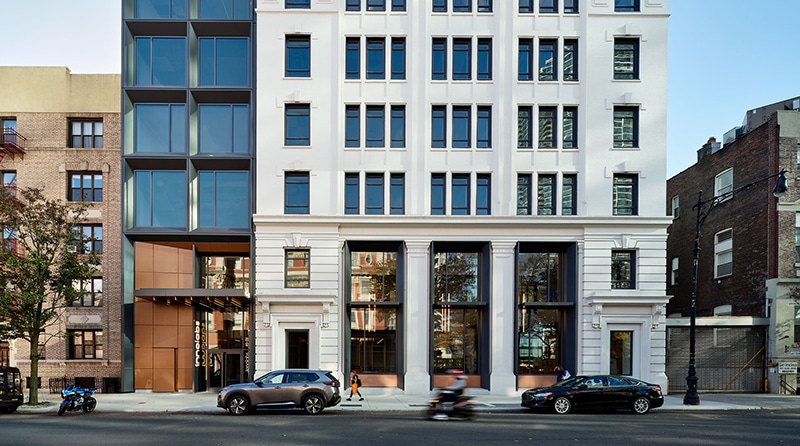When developer King Street Properties expressed interest in bringing a life-science building to New York’s Long Island City neighborhood in 2016, it was two years before Amazon pinpointed the area as a potential home to its eagerly anticipated HQ2.
The Amazon Effect
Long Island City is booming even without the e-commerce giant’s HQ2
“For King Street, it validated our thesis about Long Island City and why it made sense, not just for a building, but for a cluster,” King Street Senior Director Ed Jaram told the New York Business Journal.
But when Amazon pulled its Long Island City plans, Jaram said the move didn’t raise concerns about the area. King Street’s Innolabs now sits in Court Square, across from the building where Amazon was going to take office space while developing its proposed waterfront campus. (Construction on HQ2’s location in Crystal City, Virginia, outside of Washington, D.C., was recently paused amid tech layoffs and remote work options.)
“When HQ2 got pulled, it was for political reasons,” Jaram said. “It wasn’t because the real estate thesis didn’t work.”
In fact, despite Amazon nixing the Queens neighborhood from its future, the area has been rapidly evolving for the past decade, with interest speeding ahead following Amazon’s decision to bail from Long Island City.
Residential and office towers have been popping up — Skyline Tower topped out in 2019 to become the tallest tower in Queens, and developers including TF Cornerstone and Rockrose are working on projects there. And new retailers, including Trader Joe’s and Target — two of the most talked-about stores in the city at the moment — have signed leases in the neighborhood.
“These retailers are opening because Long Island City has finally hit that critical mass where the retailers now have confidence that there’s a local population to support those businesses,” said Patrick Smith, a Long Island City broker and head of Corcoran’s The Smith Team. “The whole area seems to have really come together, I would say, the past five years especially.”
Between 2010 and 2020, Long Island City’s population grew by 40% — five times faster than the rate of growth for the rest of the city, according to data provided by Long Island City Partnership. Jobs grew twice as fast in Long Island City compared to New York City as a whole.
Developers have also flocked to the area, raising a chickenor-egg question about what came first: population growth or real estate development.
“Regardless if Amazon came to Long Island City or not, I think you would have seen this effect happen here,” said Richard Babeck, Tri State Commercial Realty managing director, who focuses on the Queens market.
‘Ripe’ for development
Large-scale development in Long Island City started over a decade ago. Principal and co-lead of Avison Young’s TriState Debt & Equity Finance team Andrew Singer, who has been organizing financing in the area for the past 15 years, said the neighborhood was historically “old, outmoded, ugly industrial.”
The Citicorp Tower, which was completed in 1990, was previously the only iconic city-esque tower in the area. Citibank’s presence caused employees to move into the neighborhood. Following a 2003 renovation, Metropolitan Life Insurance moved more than 1,500 employees into the Brewster Building — a former manufacturing plant for Brewster and Rolls Royce cars, horse-drawn carriages and World War II airplanes — with a similar impact.
“Everything is filling in very nicely,” Singer said.
Newmark Managing Director Bill Harvey has noticed similar changes.
“Back [in 2000], One Court Square stood head and shoulders above everything else. On the occasional days that I drive to the city, it never ceases to amaze me that One Court Square is almost lost in terms of visibility along the Long Island City skyline,” Harvey said.
Still, Amazon’s interest in the area placed Long Island City on the map. In 2018, The Wall Street Journal reported that professionals were already renting and buying property in the city in anticipation of HQ2.
“When Amazon announced — I was part of that whole thing — it was the happiest day of my professional life. When they pulled out on Valentine’s Day — ‘the Valentine’s Day Massacre’ I would call it — it was probably the saddest day of my professional life,” Queens Chamber of Commerce President and CEO Thomas Grech said. “But all the reasons why they came here needed to be leveraged.”
Since 2006, more than 33,000 residential units have been completed, with another 10,000 to be slated for completion by 2025, according to a report by Long Island City Partnership. There is more than 1.1 million square feet of retail in mixed-use and renovated commercial buildings in existence, with another 318,000 to be added by 2025. Some 11 million square feet of new and renovated commercial and industrial buildings exist with another 2.8 million announced. Lastly, 42 hotels with 4,300 hotel rooms have been developed, and 38 hotels that will more than double that room count are in planning or construction.
And the shared expectation is that development has not yet peaked, as institutional property owners have not yet bought out the many mom-and-pop landlords.
“There’s definitely a pocket of Long Island City that’s ripe for this. I just don’t think they have touched it yet, because they’re waiting for turnover of ownership,” Babeck said. “Once you start to have a larger turnover of those spaces, you’re going to start to see Long Island City really take up a huge spike in development. Bigger names coming in, bigger buildings coming in, wealthier people moving in.”
From Sasha Jones at New York Business Journal:
https://www.bizjournals.com/newyork/news/2023/03/16/long-island-city.html
